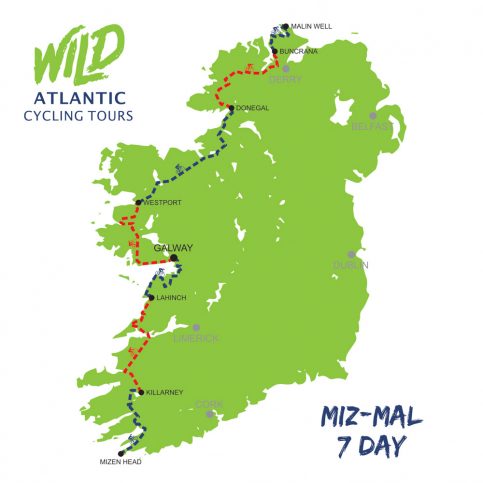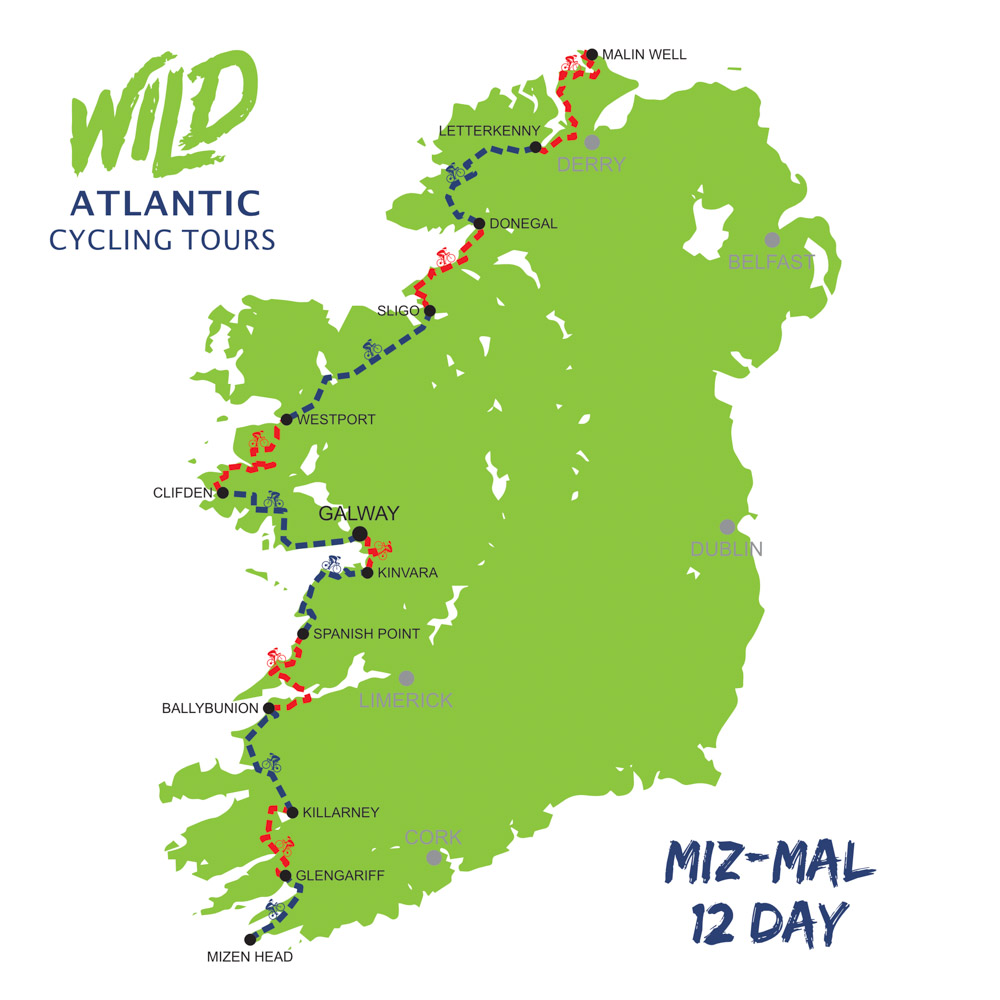
Ireland Cycle Tours: An Overview
Ireland has a rich and varied landscape! The west coast can be wild and rugged with awe-inspiring views. The terrain can be hilly, but the rewards are second to none. Ireland is quickly becoming a cycling nation. The Irish Sports Council recently reported that over 2 million people cycle regularly. At weekends, roads and trails are often buzzing with leisure cyclists out enjoying the local riding and of course the coffee and pub stops!
Roads are plentiful - almost 100,000 kilometres of them! Roads aren’t generally choked with cars and it's easy to get off the beaten track for some peace and quiet. Ireland is one of the least densely populated countries in Europe. The cycling infrastructure is constantly improving and with peaceful roads a cycling holiday in Ireland will leave you with fond and lasting positive memories.
We worked with our friends from Epic Road Rides to put together a comprehensive guide to cycling the Ireland End-to-End (MizMal) and the Wild Atlantic Way. No other tour company knows Ireland like we do!
Helpful Resources on Ireland and Cycling
- A journey of a lifetime - Ireland's 1,500 mile Wild Atlantic Way
- The Irish Tourist Board's Award Winner 'Discover Ireland' Website
- The Complete Guide to Cycling in Ireland
- Read About MizMal and the Ireland End to End
- The "Gift of the Gab" - a look at Irish language and culture
Mizen to Malin (MizMal) - the Original Ireland End-to-End Cycle Journey
Join us from Mizen Head to Malin Head, the Ireland End to End (MizMal) with Wild Atlantic Cycling. This is the Irish equivalent of Britain’s Land’s End to John O’Groats (LEJOG), but with rugged coastline, Irish music, unique landscapes and lively pubs. Mizen to Malin to really is something special.
Our End-to-End route takes in much of Ireland’s famous Wild Atlantic Way and is geared towards intermediate and experienced road cyclists. Our Mizen to Malin cycle route of Ireland's west coast has become one of the Must Do cycling holidays of Europe! Mizen to Malin was featured in the Guardian Bike Blog in July 2017.
Route Map of MizMal The Ireland End to End 7 Day Cycle Tour
Route Map of MizMal The Ireland End to End 12 Day Cycle Tour


What to Expect on a Cycling Holiday in Ireland
Landscapes when Cycling Touring in Ireland
Ireland has some stunningly beautiful scenery, from quiet rolling countryside to the more challenging mountainous areas in the south and the peninsulas of the south-west. The Wild Atlantic Way is especially attractive as one of the longest sign-posted routes in Europe! Major trunk roads can be busy in the peak seasons, however the minor roads are generally quiet unless you are close to the more touristy areas. Outside the midlands, there are hills just about everywhere, and those on the back roads can have thigh-burning grades. Road engineering is often, well, not very engineered -- instead of having switchbacks on a steep slope, roads often climb by the most direct route.
Ireland Airports
The main airports are Dublin (east), Cork (south), Shannon (west) and Belfast (north). On our Ireland End-to-End cycle trips Cork Airport is our convenient meeting point. We also provide transfers from Dublin airport.
Weather in Ireland
Anyone cycling in Ireland should be prepared for two inevitable obstacles: wind and hills! The climate is generally mild but due to it's position can pick up the full force of the incoming fronts rolling in from the Atlantic.
The best time for a cycle tour in Ireland is generally from May to October. During this period you’ll find most attractions and restaurants open and the best chances for warmer weather. However, this also corresponds with the busiest time along the designated routes such as the Wild Atlantic Way coastal route in western Ireland. Further detail on our Mizen to Malin tours primarily on the Wild Atlantic Way can be found here in the Tours section below.
April, early May, late September, or October are quieter and avoid most holidays, festivals, special events, and school breaks.
Food and Drink on Your Cycle Tour of Ireland
The Irish value hospitality, and generous portions of food are common at home and in restaurants. Expect cooking styles that are associated with the island of Ireland. It has evolved from centuries of social and political change and the mixing of different cultures, predominantly with those from nearby Britain and other European regions. The cuisine is founded upon the crops and animals farmed in its temperate climate and the abundance of fresh fish and seafood from the surrounding waters of the Atlantic Ocean. Chowder, for example, is popular around the coasts.
A large breakfast was traditionally eaten in rural Ireland and is still often available at most hotels on the island. Although lighter more 'continental' styles are also on offer. Traditional 'Full Irish' breakfast may include soda bread, pancakes, porridge, eggs, and various meat products.


